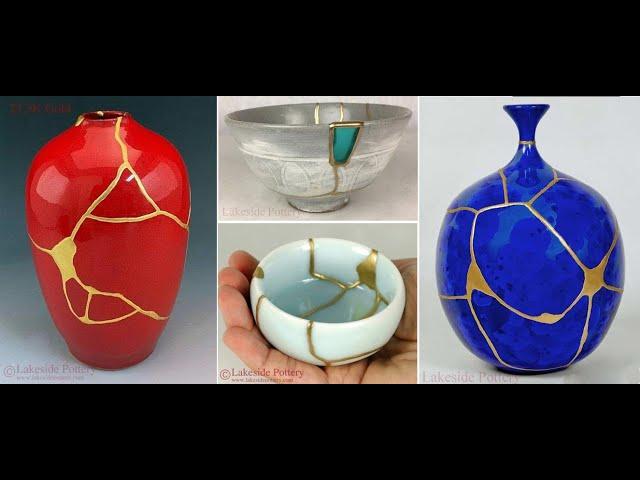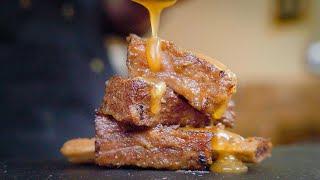
What is Kintsugi Art and Process? How is Kintsugi Repair Made? Kintsukuroi Art Lesson and Metaphor
Комментарии:

Great to see PC-Clear epoxy used to bond the pottery and also PC-11 epoxy as a filler for high quality repair on such beautiful artwork!
Ответить
Thanks for showing us this process. I always wondered how Kintsugi was done. But is this the traditional Japanese method, using epoxy? I always imagined molted gold was used, or perhaps a thin flat gold wire was melted in place.
Ответить
I love this and it actually almost makes me tear up, I have been interested in this for years and am just now wanting to make art pieces as a ways for me to heal and repair a lot of abuse in my life! Thank you for sharing ❤️
Ответить
Terrific video. I have wanted to know how to repair with gold a long time but just learned the name "kintsugi" in the last month and so had no idea whatsoever how to do it. Too bad I didn't learn this twenty years ago when I made a wonderful Raku bowl for a friend. The bowl was badly cracked and quite fragile. He is a life-long instinctive and educated maven of Wabi-sabi, so I gave it to him anyway. I would rather have used kintsugi first. Now I have a new piece of stoneware on which I will try THIS technique after it's fired. Also have a Spode beer pint my mother gave me forty years ago, which I kept after accidentally breaking it. When I get the knack, I will repair it, too.
I have watched perhaps twenty videos on kintsugi, and this one is the most helpful so far because modern, easier materials are used while there is recognition of classical methods reflected in the presentation. I have tried now for about a month to get some insight into how to use epoxy or some other modern glue to yield the look of authentic, classical kintsugi. I think this is the video that finally does it for me. Thank you so very much.

Very nice video and the step by step process is so amazing! Which kind of lacquel is used before applying gold metal? Could you link that? Thx
Ответить
This poem expresses the importance of the concept of kintsugi in my life, written well before I had ever heard of kintsugi or kinsukuroi
MOSAIC
Mosaic: a word that means from the muses, from Moses
and a work of art created from broken fragments of pottery,
stone or glass.
Even the first time, surrender was not hard,
though the grownups and mothers
with their drinks and swizzle sticks
undoubtedly thought it so when you volunteered
your only present that 10th Christmas
to a younger child who wouldn’t understand
being giftless at the tail end of a line to Santa,
nor your inherent sin in being born.
Such generosity should have stayed
between your concept-of-God and you,
but grownup admiration (you could not hope
to make your act unpublic) sullied the soap
of any generosity’s power to cleanse you.
Other atonements followed, only one
almost perfect, being perfectly anonymous
spoiled by an accomplice’s later telling.
Perfection? You never made that grade,
your terrible love for God demanding all life
from your life. No one told you, “Live a lot,”
not in words that made it matter, though
they doubtless counseled, “Live a little.”
You were always in school to be perfect,
never knowing that life is a classroom
where one learns to love flaws
by throwing bad pots, to shatter
them with careful hammer,
assembling beauty from broken things.

Fascinating!! Thanks for sharing!
Ответить
I have one particular item that I had glued with epoxy but it is not very perfect but knowing that Japanese see imperfection as beauty, I have been seeking saving this precious pottery bowl (made by my daughter). I thought I'd have to remove epoxy I had used (as I had a piece at top of bowl that was not smoothly set). But now I see that I must use technique using glue & glob of non-gold metal over uneven patch & also follow other patched-broken lines to give the whole bowl the Kintsugi effect. I love this process & thank you for showing how it is done!
Ответить
What do you use for gold substitutes
Ответить
I'm curious about the faux gold technique, it seems to leave a raised, rounded area when finished, as opposed to the levelness of the genuine gold method. Visibly, this makes it look distinctly different. Is there a way to make it look more level? Also, is the PC-11 application necessary prior to doing the faux-gold technique?
Ответить
Amazing and very pretty! Thank you
Ответить
Thanks to share !! in method 2 you mix with epoxy ?
Ответить
wonderfull video tutorial, thank you for sharing. Question: when working with your compound, the lines seem to be much thicker - as in not in line with the surface. with gold after buffing it is practically indistinguishable. i prefer the look of lines that are flush with the surface - can that be achieved with your compound?
Ответить
Beautiful
Ответить
When using the methods, which ones are food safe?
Ответить
What reddish lacquer do you use before applying the gold?
Ответить
Thank you for the video, it’s very useful. What I want to repair is glass, what would you use as filling material?
Ответить
Thank you, this video help me a lot on fixing my mom broken jade bracelet.
yep, a green bracelet with gold line , cool isn't it?

Are there other colors than just gold?
Ответить
What type of lacquer is it that you use? (what the gold is bonded to)
Ответить
thank you! it is very interesting... can we fix a coffee cup and use it for hot liquids ?
Ответить
I have table made of stone that is porous. I was wondering if I can fix the large table with this process. Can you let me know?
Ответить
Where do I purchase the gold powder??
Ответить
PLEASE , it is possble to repair a glass vase? PLEASE?
Ответить
Puedes poner el nombre de pegamentos y pinturas? Quedó bellisimo, gracias
Ответить
How long after you dust do you take off the extra gold? Also, how long do YOU let the lacquer cure for before dusting?
Ответить
Can repaired container be used for containing hot liquid?
Ответить
When using this to repair everyday dishes, are the dishes usable after repair?
Ответить
Wonderful explanation and tutorial, thank you for sharing
Ответить
❝to repiar with gold❞ the art of repairing pottery with gold or silver lacquer and understanding that the piece is more beautiful for having been broken
Ответить
🦋
Ответить
Hello, after watching the video, I am delighted with your work, tableware acquires a new look for home decoration, but it happens that ceramics want to be restored so that cracks are not visible. It is especially difficult to restore glazed colored glaze, for example, based on iron oxide.
Ответить

























